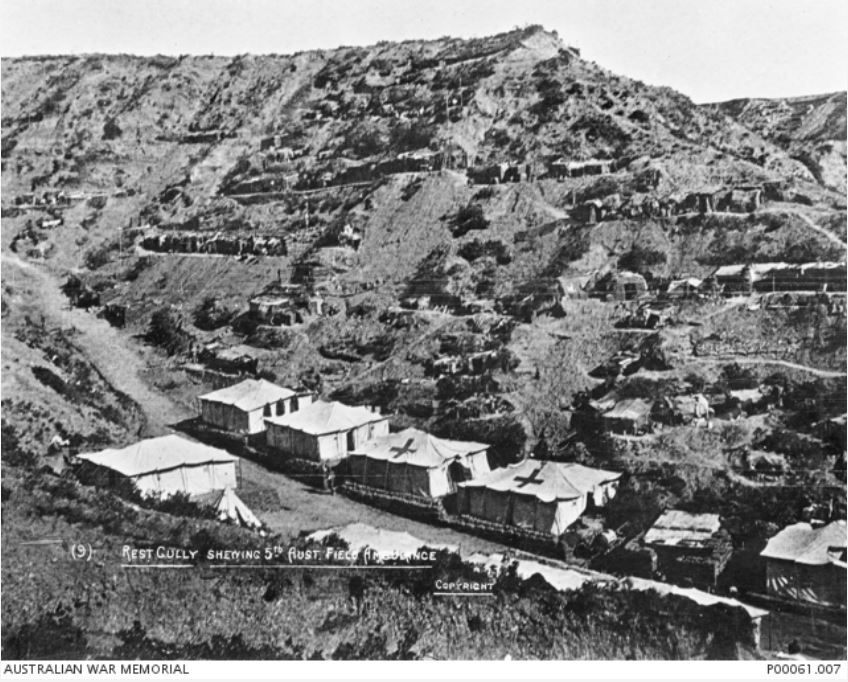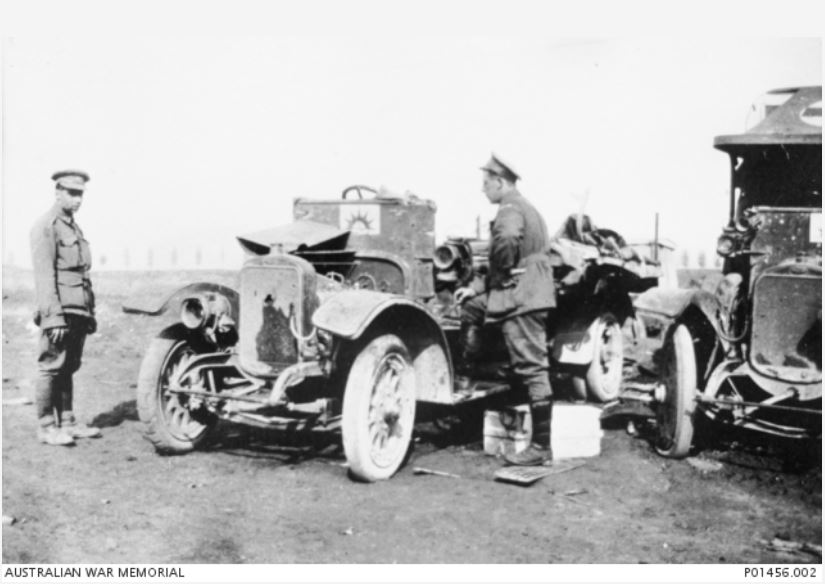Difference between revisions of "5th Australian Field Ambulance"
From Our Contribution
(→External Links) |
|||
| Line 5: | Line 5: | ||
| subheader = | | subheader = | ||
| − | | image = [[File:]] | + | | image = [[File:5th_Field_Amb_1.jpg]] |
| − | | caption = | + | | caption = 1915 Rest Gully Gallipoli - 5th Field Ambulance . AWM P00061.007 |
| − | | image2 = | + | | image2 = [[File:5th_Field_Amb.jpg]] |
| − | | caption2 = | + | | caption2 = 1916 France Damage to vehicles of 5th Field Ambulance caused by HE shell. AWM P01456.002 |
}} | }} | ||
| Line 14: | Line 14: | ||
==Brief History== | ==Brief History== | ||
| + | The Unit was first raised with the formation of A and B sections at Liverpool camp on the 15 Mar 1915. It then moved to Waverley (Sydney) where training was carried out. On 12 May 1915, one Officer and thirteen other ranks left for Egypt on board the [[HMAT A32 Themistocles]]. The Ambulance Transport Sub Divisions and part of 'C' section departed Sydney on 31 May 1915 on board [[HMAT A31 Ajana]], with the remainder of the unit departed on 25 Jun 1915 aboard [[HMAT A40 Ceramic]]. | ||
| + | Proceeding to Port Tewfik, the troops were then railed to Heliopolis on the outskirts of Cairo, where they went into camp. After training and equipping, the field ambulance departed for Gallipoli (minus its transport element) arriving at Anzac Cove before daylight on the 22 Aug 1915, and they disembarked in the early hours of the morning with the last party reaching the shore just after daybreak. Later that day, the stretcher bearers were called on to assist in carrying wounded from Hill 60. | ||
| + | On the following day, they set up its first Dressing Station by establishing an Aid Post at Waldrons Point. In less than 10 hours, 307 casualties passed through the Aid Post. The stretcher-bearers had to carry patients up to 3 miles, and the unit suffered its own first casualty, a stretcher bearer who was killed collecting wounded in no mans land. On the 7 Sep 1915 'B' section moved to Popes Post while 'A 'and 'C' sections went to Rest Gully. Between 23 Aug and 31 Nov 1915, 2,934 patients were seen by the unit with 969 later able to rejoin their unit. | ||
| + | Following the evacuation, they spent a few days at Lemnos before sailing for Egypt. Disembarking in Alexandria on 8 Jan 1916, they traveled by train to Tel-el-Kabir, and then on to Ferry Post on the Canal. Here, 'C' section was split off to form part of the ''15th Australian Field Ambulance'' with the remainder leaving for France on 17 Mar 1916, aboard [[S.S.Arcadian]]. They arrived in Marseilles on the 22nd, and the following night left by train for a small French village in Northern France. | ||
| + | On 1 Jul 1916, the unit moved to the Somme region to support a major offensive at Pozieres. During the first phase of the battle, they handled all casualties from a Divisional front with all passing through their HQ at Becourt Chateau. This was followed by a weeks rest at Canaples where the unit was brought back up to strength before rejoining the line on 29 August. The battle for Pozieres had moved on to Mouquet Farm with heavy casualties still the norm. A week later they were moved to Vardencourt near Ypres for a rest before moving back to the Somme for the winter. | ||
| + | Stretcher squads were active with the leading infantry elements as the Australians followed the German retreat to the Hindenburg Line, and their next major involvement came with the Battel for Bullecourt where many of their personnel became casualties due to the difficult task associated with the retrievals of casualties. A lengthy rest followed during May, June and July, before the unit moved to the St Omer district and further training took place. They were back in action with the battles for Polygon Wood, Poelcapple, and Passchendaele. | ||
| + | |||
| + | |||
| + | During the ''Hundred Days'' in 1918 they wer active in the battles for Villers-Bretonneux, Mont St Quentin and Montbrehain. Forty two men died while posted to this unit. | ||
===Individual Honours=== | ===Individual Honours=== | ||
| − | + | * 3 x Distinguished Service Order | |
| + | * 1 x Distinguished Conduct Medal | ||
| + | * 44 x Military Medal | ||
| + | * 4 x Bar to Military Medal | ||
| + | * 7 x Meritorious Service Medal | ||
| + | * 10 x Mentioned in Despatches | ||
| + | * 3 x Belgium Croix de Guerre | ||
| + | * 1 x French Medaille Des Epidemies, Silver | ||
====Notes==== | ====Notes==== | ||
Revision as of 01:38, 10 June 2021
 1915 Rest Gully Gallipoli - 5th Field Ambulance . AWM P00061.007 | |
 1916 France Damage to vehicles of 5th Field Ambulance caused by HE shell. AWM P01456.002 | |
Brief History
The Unit was first raised with the formation of A and B sections at Liverpool camp on the 15 Mar 1915. It then moved to Waverley (Sydney) where training was carried out. On 12 May 1915, one Officer and thirteen other ranks left for Egypt on board the HMAT A32 Themistocles. The Ambulance Transport Sub Divisions and part of 'C' section departed Sydney on 31 May 1915 on board HMAT A31 Ajana, with the remainder of the unit departed on 25 Jun 1915 aboard HMAT A40 Ceramic.
Proceeding to Port Tewfik, the troops were then railed to Heliopolis on the outskirts of Cairo, where they went into camp. After training and equipping, the field ambulance departed for Gallipoli (minus its transport element) arriving at Anzac Cove before daylight on the 22 Aug 1915, and they disembarked in the early hours of the morning with the last party reaching the shore just after daybreak. Later that day, the stretcher bearers were called on to assist in carrying wounded from Hill 60.
On the following day, they set up its first Dressing Station by establishing an Aid Post at Waldrons Point. In less than 10 hours, 307 casualties passed through the Aid Post. The stretcher-bearers had to carry patients up to 3 miles, and the unit suffered its own first casualty, a stretcher bearer who was killed collecting wounded in no mans land. On the 7 Sep 1915 'B' section moved to Popes Post while 'A 'and 'C' sections went to Rest Gully. Between 23 Aug and 31 Nov 1915, 2,934 patients were seen by the unit with 969 later able to rejoin their unit.
Following the evacuation, they spent a few days at Lemnos before sailing for Egypt. Disembarking in Alexandria on 8 Jan 1916, they traveled by train to Tel-el-Kabir, and then on to Ferry Post on the Canal. Here, 'C' section was split off to form part of the 15th Australian Field Ambulance with the remainder leaving for France on 17 Mar 1916, aboard S.S.Arcadian. They arrived in Marseilles on the 22nd, and the following night left by train for a small French village in Northern France.
On 1 Jul 1916, the unit moved to the Somme region to support a major offensive at Pozieres. During the first phase of the battle, they handled all casualties from a Divisional front with all passing through their HQ at Becourt Chateau. This was followed by a weeks rest at Canaples where the unit was brought back up to strength before rejoining the line on 29 August. The battle for Pozieres had moved on to Mouquet Farm with heavy casualties still the norm. A week later they were moved to Vardencourt near Ypres for a rest before moving back to the Somme for the winter.
Stretcher squads were active with the leading infantry elements as the Australians followed the German retreat to the Hindenburg Line, and their next major involvement came with the Battel for Bullecourt where many of their personnel became casualties due to the difficult task associated with the retrievals of casualties. A lengthy rest followed during May, June and July, before the unit moved to the St Omer district and further training took place. They were back in action with the battles for Polygon Wood, Poelcapple, and Passchendaele.
During the Hundred Days in 1918 they wer active in the battles for Villers-Bretonneux, Mont St Quentin and Montbrehain. Forty two men died while posted to this unit.
Individual Honours
- 3 x Distinguished Service Order
- 1 x Distinguished Conduct Medal
- 44 x Military Medal
- 4 x Bar to Military Medal
- 7 x Meritorious Service Medal
- 10 x Mentioned in Despatches
- 3 x Belgium Croix de Guerre
- 1 x French Medaille Des Epidemies, Silver
Notes